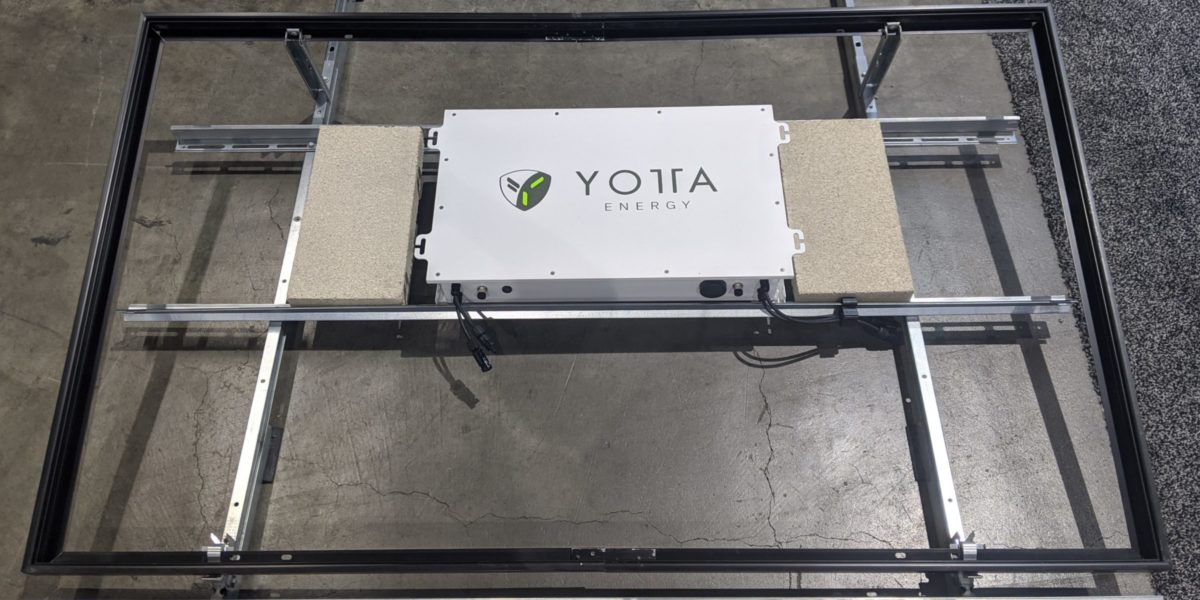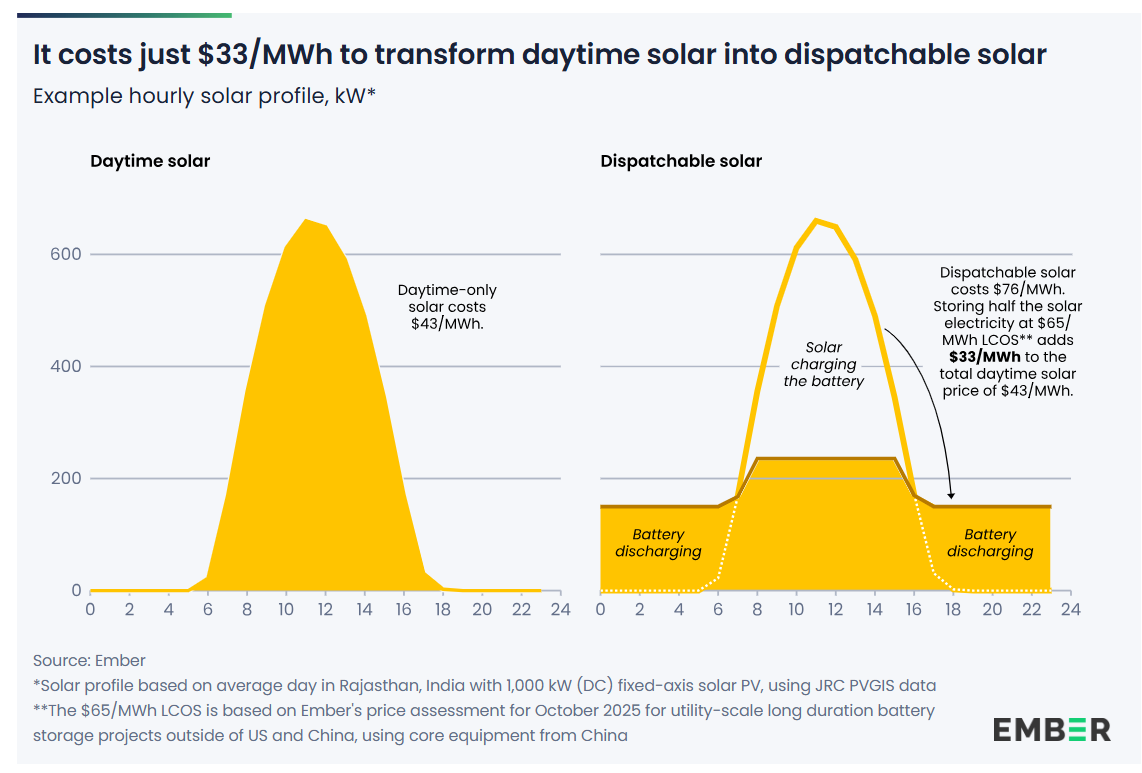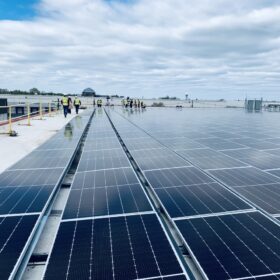Yotta Energy has designed a one-kilowatt-hour battery that mounts underneath a roof-mounted, environmentally-exposed solar module.
Ten years ago, the idea of putting a microinverter or optimizer behind a rooftop solar panel was a bit of a reliability stretch. Today, module-level panel electronics warrants its own acronym and enjoys an 80% percent market share in the U.S. residential solar market.
Yotta Energy believes batteries are headed in the same direction — to module-level micro-storage — and is deploying a 52-pound, 1 kW-hr lithium iron-phosphate battery on the same solar module racking gear that holds the ballast.
CEO Omeed Badkoobeh believes any safety and reliability concerns are rendered moot by the stable battery chemistry and the company’s solutions to thermal issues.
The CEO told pv magazine that its temperature-control methods are “completely solid state.”
There are no active components on “the hot side” — no moving parts, no fans, no pumps, no Peltier coolers, no power usage. On “the cold side,” the firm does use power in its phase-change heat exchange system, a technology used in space applications.
The CEO sees this as a solution for solar-plus-storage “in the urban environment.” The company is rolling out several pilot deployments with strategic partners.
Yotta works with solar developers. “Many solar developers get requests for storage,” but settle for just doing solar now out of inexperience or availability. “We see that shifting,” said the CEO. “Soon it will be automatic to deploy storage.”
Badkoobeh claims Yotta’s system, “allows for the lowest installed costs for adding energy storage to any solar PV system. The ability to remotely design and conserve space opens up opportunities for more solar installers to incorporate energy storage.” The CEO said the Yotta product enables the “ability to install just the right amount of storage and the ability to expand.”
Yotta’s funding has come from grants and $1.5 million in seed funding from undisclosed investors. The CEO is working on follow-on funding to keep the ten-person company moving ahead.
Hasn’t this been done before?
SolPad unstealthed in 2016 with bold claims of a yet-to-be commercialized solid-state battery that was installed, like Yotta, under the module along with a microinverter. Four years later, replete with new CEO Terry Jester, SolPad is still developing the technology and coming to market this year.
Barry Cinnamon, an experienced solar and storage installer at Cinnamon Energy Systems has worked with SolPad. He told pv magazine: “I think the idea has a lot of potential. The physical constraints of finding room for batteries on the sides of houses are very challenging, and getting worse with new codes. So — putting the batteries on the roof avoids that problem completely. Carrying up a bunch of 40-pound batteries is much easier than installing a 220-pound battery on the side of a house. There are also some interesting design issues with either sending DC power down from the roof (to a backup inverter), or actually doing the backup power generation on the roof with micros.”
According to SolPad cofounder, Christopher Estes, the startup “has a very sophisticated energy storage and energy analytics solution that is far superior in all aspects,” which is the kind of thing cofounders say.
SolPad’s current CEO and solar industry veteran, Terry Jester tells pv magazine, “We have a full suite of products including load controller (for demand charge management/reduction), inverter (1 kW), battery storage (2 kW-hr), gateway, junction boxes and all the wiring needed to install a system.”
“We’ve shipped our first load controllers and are excited that we are nearly through UL certification with our product suite (several components such as the battery, junction boxes and the cables are complete), with expected shipments of the inverter storage system in Q2 of 2020. The inverter is GaN based, bi-directional and will delivery almost 10% more energy than products out there now because of low parasitic losses and high inverter performance — even in low power ranges. We can run off-grid with ease and the load controller will manage the battery state of charge/load shedding if off-grid for extended periods of time.”
Another startup with similar ideas, JLM Energy, claimed 20-year warranties for module-level storage, right before it went bankrupt.
Getting through “the arc of acceptance”
Yotta’s CEO cites a large battery design that “took a year to site,” noting that it required fire suppression systems and had to be a certain distance from the building. He added, “Every project for energy storage is a custom-engineered process.” He said that storage is complex and expensive and “people don’t want to take the technical risk.”
He added, “Centralized systems require a lot more human intervention.”
In an interview with pv magazine, John Powers, CEO of software startup Extensible Energy said, “Batteries are great. Utilities are deploying batteries on the grid. But a 20 kw-hr battery in a commercial building is large, complicated and requires fire suppression. The installed cost is many times the cost of the battery itself.”
These seem like decent reasons to go with a lot of small, UL-certified batteries on commercial buildings and residences.
CEO Badkoobeh knows he “must get through the arc of acceptance.” He used that term several times during the interview.
Cinnamon notes, “The challenge for every company with batteries and inverters is getting the requisite UL certifications — and making sure the system works. It’s expensive and time-consuming.”
This content is protected by copyright and may not be reused. If you want to cooperate with us and would like to reuse some of our content, please contact: editors@pv-magazine.com.








“Yotta Energy believes batteries are headed in the same direction — to module-level micro-storage — and is deploying a 52-pound, 1 kW-hr lithium iron-phosphate battery on the same solar module racking gear that holds the ballast.”
Ambient temperature still effects the ability of the battery chemistry to store and provide power “solid state temperature control methods” is not a magic bullet for battery longevity or function. In Southern States of the Union, several days of 100 degree F (in the shade) is what on the roof of one’s home? In areas of snow, how well does the particular chemistry discharge when needed? I can see the NFPA weighing in on batteries on the roof, better off with the unit in a NEMA 3R enclosure in an environment where temperature is controlled more than freezing to oven like.
“Yotta’s CEO cites a large battery design that “took a year to site,” noting that it required fire suppression systems and had to be a certain distance from the building. He added, “Every project for energy storage is a custom-engineered process.” He said that storage is complex and expensive and “people don’t want to take the technical risk.”
Specifics on this “particular” design may make it a “safer” installation and product and yet expensive as a larger “stand alone” battery storage system may be, much of the mounting, monitoring, remediation aspects of the system are installed using well understood and standing NEC (“best practices”) that have proven themselves over the decades of use. I have seen remote telemetry battery systems dry out, gas out and blow up batteries. It’s a good thing the batteries had their own (metal box) with a vent on top, or it could have been worse. Using the bottom of a solar PV panel and the roof as a containment system when a battery fails into thermal runaway does not a best practice make.
Remember the Surprise Arizona fire and explosion in the APS energy storage container last year? One of the very findings of why the site exploded, is fire suppression built into the cargo containerized system had fire suppression on board, but the battery pack that went into thermal runaway gassed out and created a volatile atmosphere in the pack enclosure. When the facility door was cracked it allowed the volatile gasses to catch and explode. Venting out the gasses from the battery pack “container(s)” to air could have stopped this incident. Does Yotta do that?
I definitely like the small, modular type of battery. Xcel in Colorado is going to start doing a tiered pricing system. So a lot of people will probably start looking at enough battery to fill the gap between midday and overnight pricing. Not sure when it starts.
Most battery systems have gone to AC tied for backup when the grid is down. It was easier to do than also have an inverter line for disconnecting from the grid.
I disagree with adding more items at the panel, for temperature, safety, and serviceability reasons. Optimizers are great, but I stay away from micro inverters. Batteries at the panel isn’t ideal.
Interested, for a ground level system which eliminates structural risks of fire.
You mightg want to rethink your aversion to microinverters. Far better technology, and they solve a lot of technical challanges.
Building a solar system to charge tesla truck and wondering what is the best system set up to do that?
The Battery under a (350W..??) PV Panel looked very interesting… till I saw the weight 52lbs….. more than the Panels themselves …. Wow!!!
Some years back there was “talk” of Polymer Battery Solar Tiles (Solar +Storage+Roof Tile… all in one)… not sure what happened. The advantage with Polymer would be their light(er) weight.
This brings me to the main issue…. why are Batteries so heavy and why does it have be an Electro-Chemical Device using a 200+/- YEAR OLD TECHNOLOGY.
In the end…. we are just “storing electrons” which are (one of) the lightest of all atomic particles. I am sure if one had to store One KWhr of electrons… the weight of these electrons by themselves…. would be possibly (I have not calculated it and leave it to the readers) a mere gram (mico.. pico..nano…??).
So… if we really have to store Electrical Energy we have to have a much “smarter solution” using Technologies and Concepts that possibly do not exist today.
In our earnestness to bring “products to market” quickly and cheaper…. we have failed to ask ourselves fundamental questions like these and then (Re)Search, Fund-n-Find …… DISRUPTIVE TECHNOLOGIES…. THAT CREATE REAL BREAKTHROUGHS….
Can you imagine Electric/Electronic Devices… Cell Phones, Laptops, Solar Panels, Vehicles etc… with Batteries that weighed…. let us say… not more than 10 times the weight of the Electrons required to be stored….. aka negligible. Yes… just Imagine….
Now with respect to Day/Night Storage of Solar Power, we should be looking at multi-TW, East-West Grids that would transfer Solar Power from the Day(Bright) to the Night (Dark) Side of the Earth and eliminate the need for Grid Size Batteries altogether… like the Local Grid, that does this, at present for Grid connected PV Systems.
We must not be complacent as we….. have not seen anything yet!!!
It’s going to be ending of mine day, but before finish I aam reading thijs wonderful article to improve my experience.